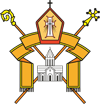Surb Sion (Surb Hakob) Church of Tsughrut-founded
Church construction and renovations: The village of Tsughrut is located in the Akhaltsikhe district of Samtskhe-Javakheti ,5km north-west from the Akhalkalaki straight line. Surb Hakob Church of Tsughrut village was built in the 1830s. In 1863, the church was still wooden.[1] According to the inscription preserved up to now above the southern entrance of the church, in 1881, an entirely new church was built on the site of the old church.[2]
In the archives on the village of Tsughrut of the 1830-1840s ,[3] the church is mentioned by the name of Surb Hakob. After that, and particularly in 1875,[4] it is already mentioned by the name of Surb Sion. As of the mentioned year, the church was obsolete and needed a repair. In essence, as a result of previous reconstructions and rededication ceremonies, the church has already received the name of Surb Sion, but as it was mentioned, the entirely new church of Surb Sion was built in 1881.
Church Gospels: The 395-page parchment gospel written in 974 by Hovhannes Writer is still kept in the village up to now.[5] One of the earliest testimonies on the existence and the description of the manuscript dates back to 1873. The testimony states: "Here is a Gospel that deceased Karapet bishop has brought from Surb Hovhannes monastery of Sper, Karin, along with other ornaments ...”[6] The Gospel of Tsughrut and the Printed Dinner book, published in Venice in 1686, are also remarkable. The latter is famous especially for several manuscripts of the 18th-19th centuries. Apart from the Gospels, the conservative people of Tsughrut also keep various church items in their homes, such as pyx, khorúgv (banner), etc.[7]
School: According to the article published in “Meghu Hayastani”(Bee of Armenia) in 1873,[8] by the efforts of S. Parzyants, a school was opened in the vestibule of the church where classes were held only in summer. Initially, the school was kept at the expense of the Church’s material entries and on the account of the benefits provided by the Caucasian Charity Fund in the first decade of the 20th century. In another record, as of 1908, a one class-school functioned in Tsughrut, and the neighboring Tsira village also made use of it.[9]
Parish priests. Regardless of circumstance of being a crowded village, Tsughrut has occasionally joined the ranks of the priestless villages. However, names of priests, who priested in the church, are regularly mentioned. In the 1830s the priest of Surb Hakob Church was mentioned Stepan Ter-Nahapetyants.[10] On March 24, 1851, Mkrtich Ter-Sargsyants was ordained priest in Tsughrut. In 1876, Mkrtich Ter-Sargsyants also cared for the spiritual needs of the residents of the neighboring Tsira village. In the same year, Hovhannes Aleksanyan is mentioned as a psalm-reader.[11]
in the church, are regularly mentioned. In the 1830s the priest of Surb Hakob Church was mentioned Stepan Ter-Nahapetyants.[10] On March 24, 1851, Mkrtich Ter-Sargsyants was ordained priest in Tsughrut. In 1876, Mkrtich Ter-Sargsyants also cared for the spiritual needs of the residents of the neighboring Tsira village. In the same year, Hovhannes Aleksanyan is mentioned as a psalm-reader.[11]
In 1904-1909ss Vardan Hovhannisyan Vardaniants (born in 1861, ordained on April 2, 1896) is mentioned the priest of Tsughrut. In May 1912, the residents protest against the facts that their crowded village and the neighboring Tsira village has been left priestless for seven months and as a result of which the church was closed. After a long search, the residents of Tsughrut finally find at once two appropriate priest candidates, Yeghishe Ter-Hakobyan and Gevorg Barseghyan. The first is finally selected the priest. In 1917, Yeghishe Ter-Hakobian was remembered as a parish priest.[12]
According to the monument expert S. Karapetyan's citations, based on the documents stored in the National Archives of Armenian, the mentions on the priesting priests in the Surb Sion church of Tsughrut, as well as further testimonies (by the residents of the village and adjacent settlements) speak about the fact that the church was permanently active. The Church and the famous Gospels kept in the village have always been in the center of attention and care of local residents, which have constantly brought many pilgrims to Tsughrut.
Dedication of the Church Cross-stone(Khachkar): On October 8, 2013, with a solemn and blessing ceremony in the court of Surb Sion Church of Tsughrut village of Akhaltsikhe, a cross-stone(khachkar) was erected and rededicated by the general vicar of Samtskhe-Javakhk and Tsalka, T. Babken monk Salbiyan. The Church continues to function today as well, bringing its spiritual service to the local residents.
Sanctuaries: Surb Hakob, Surb Gevorg, Surb Karapet, Surb Mariam Astvatsatsin chapels are located in the neighborhood of Tsughrut .[13]
Diocese of the Armenian Apostolic Church in Georgia
Armenian Historical and Cultural Heritage Study Center in Georgia
[1] See NAA, ֆ. 53, ց. 1, գ. 3843, թ. 60-61:
[2] See S.Karapetyan, Akhaltskha, Yerevan , 2008, p. 226
[3] See NAA, ֆ. 53, ց. 1, գ. 456, թ.18-ի շրջ.-19; գ. 3800, թ. 4:
[4] See “Meghu Hayastani”, 1875, N 50, p. 2:
[5] See S. Karapetyan, in the same place, p. 226
[6] “Meghu Hayastani”, 1873, N 32, p. 2:
[7] See Karapetyan, in the same place, pp. 227-229.
[8] See "Meghu Hayastani" in the same place.
[9] NAA, ֆ. 28, ց. 1, գ. 300. թ. 15-ի շրջ.:
[10] See NAA, ֆ. 53, ց. 1, գ. 456, in the same place
[11] See NAA, ֆ. 53, ց. 1, գ. 3868, թ. 16:
[12] See S. Karapetyan, in the same place, p.230
[13] See in the same place, p. 229.
 Հայերեն
Հայերեն  ქართული
ქართული  English
English  Русский
Русский 


